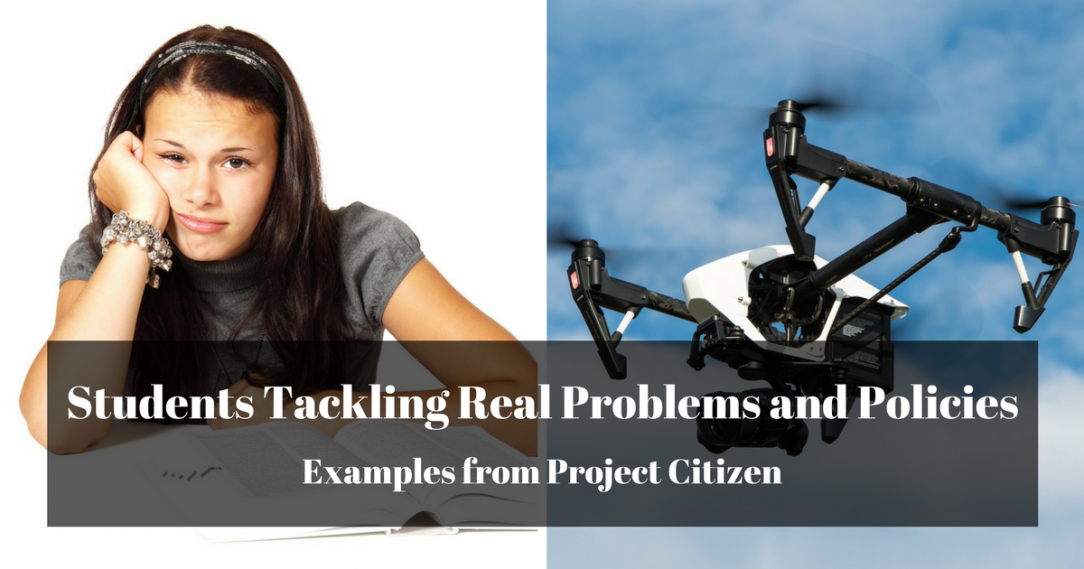
Examples of Project Citizen Winners and Project Based Learning
Project Citizen is a textbook and curriculum designed to help you teach civics through project based learning. You can make it the centerpiece of your civics class or incorporate it as an extended project into a history class.
If you’re not familiar with the program, you can read more about Project Citizen here.
But today I wanted to take a look at some examples of winning projects from statewide project citizen showcases to give you an idea of what students have done through this program. It’s about to be the start of a new semester, and this would be the perfect time to launch the project to carry you through the end of the school year.
The three projects that we’re going to look at are winners from the New Jersey showcase. One is from 2016 and two are from 2017. As part of the project, students have to complete a digital portfolio and that’s what we’ll be looking at. You can take a look at other winners going back to 2012 here.
Reducing Student Stress by Getting More Rest
This first project was a first place winner in 2017, and it was completed by Michael Savino’s class at Ridgefield Park Jr/Sr High. The problem they identified is that student are not getting enough sleep and their academic performance is suffering because of it.
The first group described how they came to choose this topic. They interviewed an adult about problems in the school and community to gather suggestions. They eventually narrowed it down to students’ sleep deprivation and researched the causes and effects of this. They cited research showing that adolescents need about nine hours of sleep each night, and other research showing that an adolescents’ biological clock makes it harder for them to fall asleep before 10 or 11pm. This is also a timely issue in the state of New Jersey, as the Governor had commissioned a Study Group to issue a report on the problem. That report was released in April 2017 (presumably after this group had finished their research).
So what can be done about this problem?
The group offered four potential solutions:
- Delay school start times. They cite research from a group called Start School Later, Inc, which presumably is a group lobbying for later start times. They reference several schools throughout the country that have made the switch.
- Flip school start times so that elementary schools report first, followed by middle schools, and followed by high schools. This would allow adolescents to sleep in and take advantage of the fact that elementary students naturally wake up earlier.
- Teaching better sleep habits in health class. By teaching better sleep habits, students will get more sleep and be more rested… in theory.
- Switching academic and non-academic classes. Schedule non-academic classes like gym first thing in the morning so that students are more awake in their core classes.
Each of these solutions was presented with a list of pros and cons to consider. They ended up making five specific policy suggestions:
- Doing More Physical Activity. Create incentives for students to lead more active lifestyles which would ultimately make them more tired and allow them to fall asleep earlier.
- Flipping Start Times. Have elementary schools start first and high schools start last.
- Scheduling of Nonacademic Classes. Scheduling non academic classes earlier and core academic classes later in the day.
- Better Nutritional Support and Incentives. Helping students eat healthier, including breakfast, so that they have more energy for the day.
- Homework Ban or Reduction. Reduce the amount of homework given so that students can go to bed earlier.
Finally, they reported on their action plan for advocating for change. They sent letters to their legislators and made presentations to local school officials. They reported that the Superintendent indicated that the district’s homework policy would be examined over the summer – a minor success for the team.
Overall, this was an excellent topic and they identified some great research and arguments. But I think the group copped out a bit by identifying five solutions instead of choosing one or two. For example, if they had focused on flipping start times and the homework ban they might have had a more focused presentation and had a greater chance of success with the board. The policy solutions were also a bit vague.
I think this highlights both the strengths and weaknesses of Project Citizen. It’s great for getting kids excited about a topic and researching possible solutions. It’s not always great about teaching them how to narrow things down to a specific policy solution and executing a plan to follow through on that proposal. This is where something like Solutions Civics would be helpful.
Drones Over New Jersey
The next project was a 2nd place winner in 2017, completed by Sarah David’s class at Florence M. Gaudineer Middle School in Springfield. They dealt with the problem of drones being misused and unregulated.
The first group defined the problem. With new, relatively cheap drones on the market for consumers, their use is increasing. This can lead to three potential problems. They pose a danger to aircraft in the area and a collision with a drone could potentially be catastrophic. Drones can be used to spy on people and invade their privacy. Finally, drones are being used by ISIS in Iraq and Syria, and it’s conceivable that they could be used in a terrorist attack on American soil. They identified some current regulations about drones but argued that they’re insufficient.
They identified four bills that had been introduced on this topic in the New Jersey Legislature. One was passed by the Senate but not the Assembly, requiring the registration of certain drones and forbidding them from flying over certain areas (S-3183). Another one was pocket vetoed, which would have set standards for how law enforcement agencies could use drones (S-2310). Two others died in committee – including one that would have required retailers to post FAA regulations (S-3174) and one creating a no-fly zone within 12 miles of airports (A-4807). They included a pro and con analysis for each of these bills. This is an impressive amount of research for a 7th grade class.
They recommended three solutions:
- Institute requirements for buying a drone, including a class on safe usage and/or a licensure requirement.
- Create a no-fly zone around certain public buildings, including schools.
- Require background checks for buying drones, excluding people with sex offense or grand larceny convictions.
Again, each policy has an analysis of pros and cons. This is a thoughtful list of policies, building on existing proposed policies (i.e. no-fly zones around airports) and offers novel solutions that addresses their stated problems (dangers of using drones and an invasion of privacy).
Their action plan includes a thoughtful list of people to contact to ask for support. They identified sponsors and co-sponsors for the bills they had researched, as well as the heads of related government agencies (like the Port Authority) and corporations that would likely oppose it. This is a great first step and shows a more sophisticated approach to grassroots lobbying than simply contacting local legislators.
STOP – Student Health and Mental Stress
The third and final project is a first place winner from 2016, and it was created by Suzanne Ward’s class in Ridge High School in Bernards Township. Their problem is the amount of stress experienced by teens today and the potential problems that can cause.
According to the group, a majority of students at their high school reported being stressed and having anxiety about school. Potential causes for this included a lack of sleep, an excessive amount of homework, and demanding expectations for things like AP classes. They surveyed their school and also provided research from other student populations around the country. Finally, they suggested that the rising rate of teen suicides could be linked to this rising level of stress.
They offered three potential solutions:
- Self Responsibility and Expansion of the Role of the Guidance Counselor. Students should do a better job of choosing between competing demands instead of trying to do everything. To accomplish this, guidance counselors would offer seminars and meet with students to help them deal with time management and stress. In the pros and cons for this policy, they didn’t mention that this would increase the workload of guidance counselors and would likely necessitate hiring more guidance counselors as a result (which isn’t a bad thing, but it’s not a cheap thing either).
- Later Start Times. Delay the start time for Bernards Township schools by one hour. I like how this policy was very specific with the amount of time to delay school start times.
- Parent Responsibility. Offer seminars and trainings for parents to help them moderate their own expectations and communicate those expectations to their children. This is an innovative idea, but I’d like to hear a bit more about how specifics.
The three policies they selected to advocate for were:
- Policies regarding scheduling of tests. Ensure that tests in core classes were not scheduled on the same day or give students a chance to reschedule these tests. This reminds me of the year that I had three final exams on the same day in college…
- Increase school funding to decrease student to teacher ratios. This would allow for more attention from the teacher, greater student success, and lower student stress.
- Locally funded programs for teens and parents. Seminars funded by local municipalities to teach students about stress management.
As part of their action plan, they made a presentation to the Board of Education and planned to have more students share testimonials at board meetings. They identified the PTO as a stakeholder group that could help influence policymakers.
What Are Your Students Tackling?
So you see there’s a variety of issues that students can tackle – from local issues like start times and student stress to statewide issues like drone safety. It’s also worth looking at the example projects to put things in perspective. Your students don’t have to be perfect to do a good job or to learn from the process. All of these projects had exceptional qualities, but they also had significant shortcomings in places.
The point of Project Citizen isn’t to change the world – it’s to help students master the skills they’ll need to change the world. It’s always a nice bonus when students have success in changing policies, but that’s not the only barometer for success of the project.
So with the new semester coming up, are you going to be using Project Citizen? What are your students going to work on? Leave a comment below.
If you’re thinking about using Project Citizen but not quite sure, you can read more about how to incorporate it into your class here. And here’s a list of five Project Citizen ideas at the school level that you can use to get your kids started.
